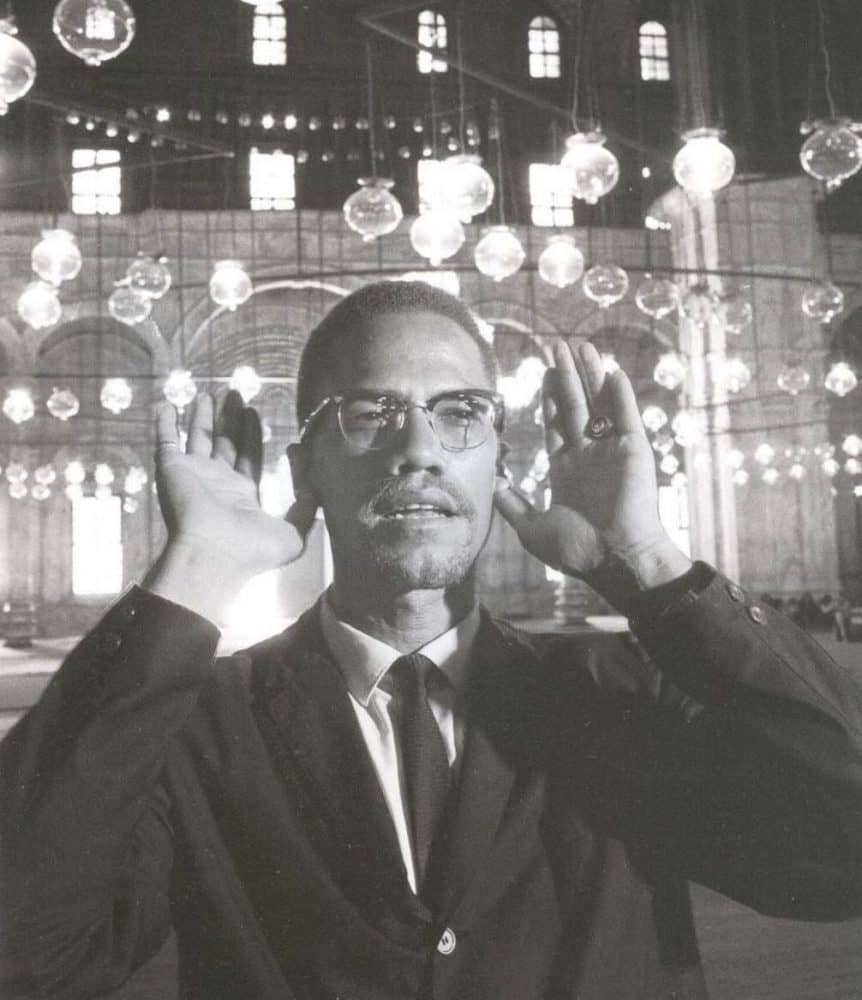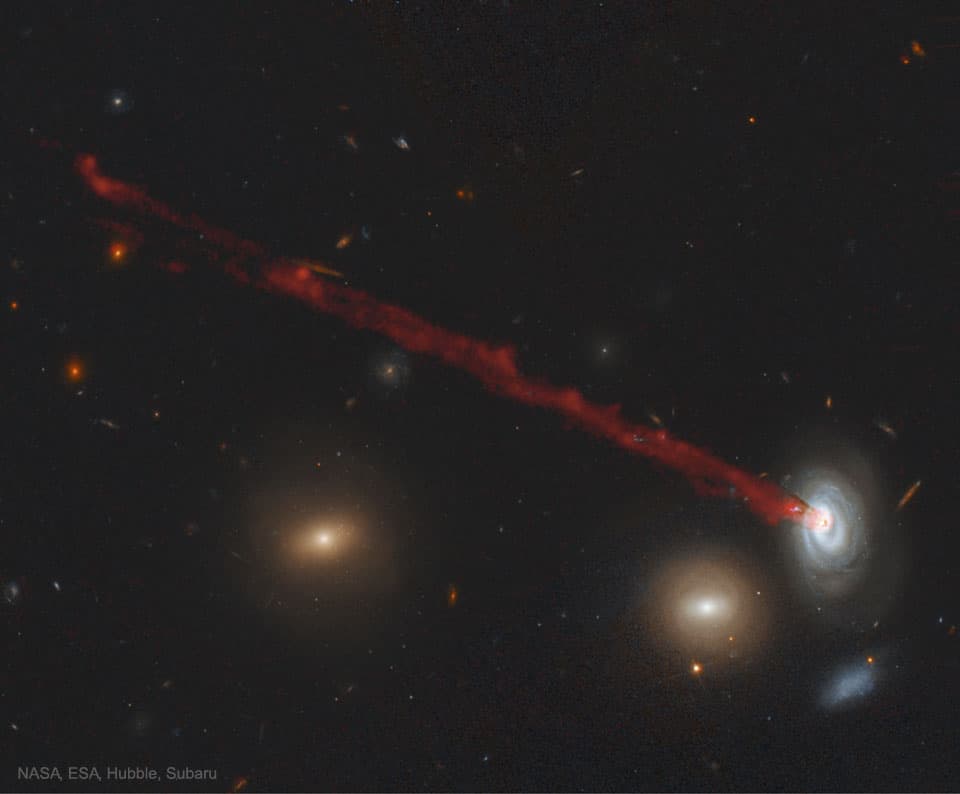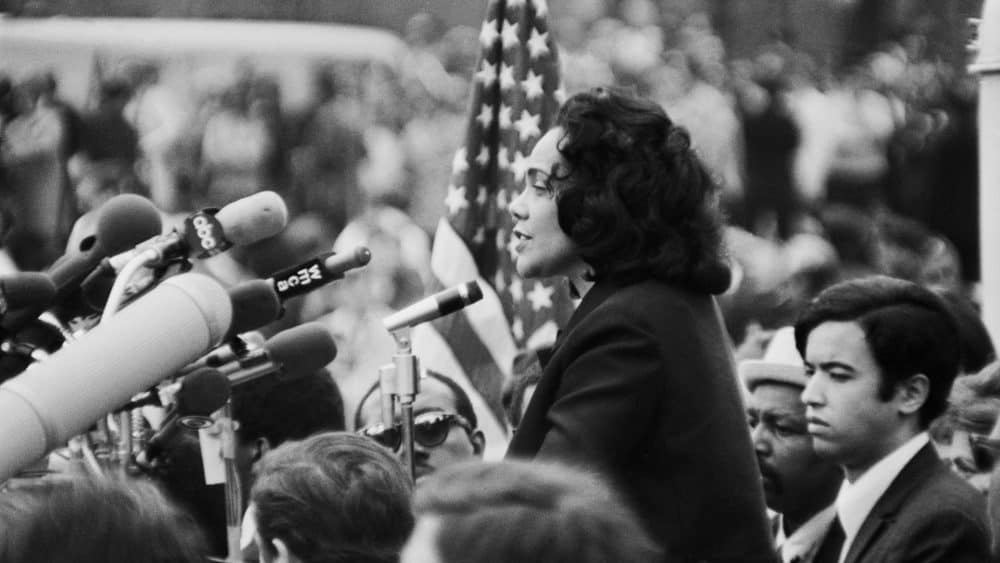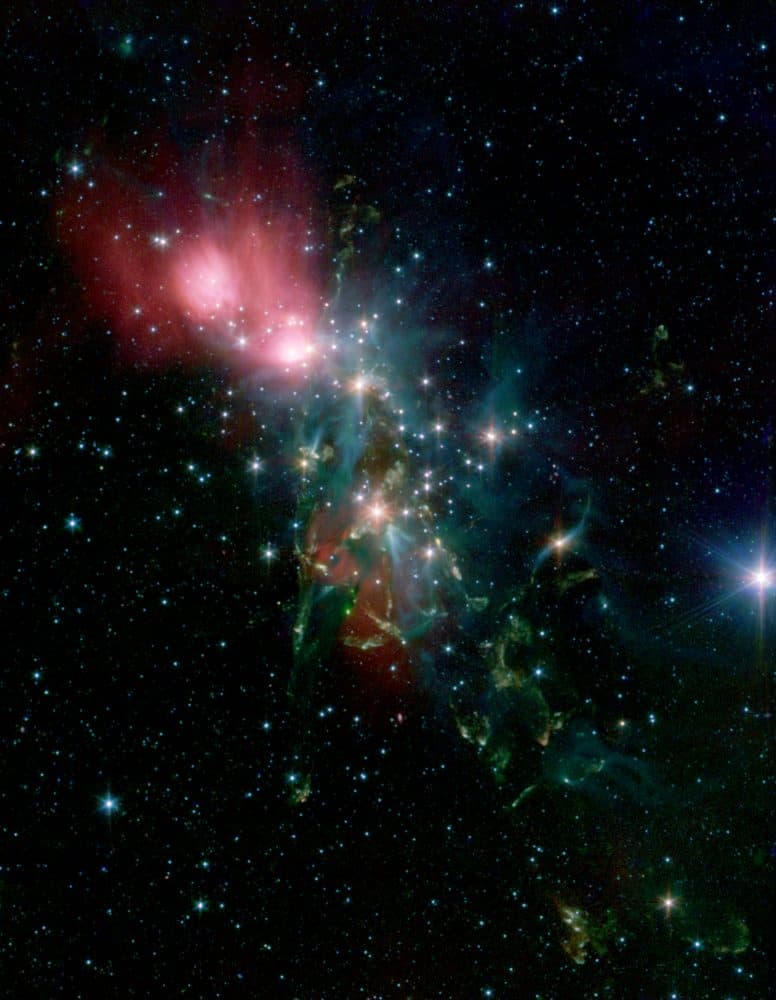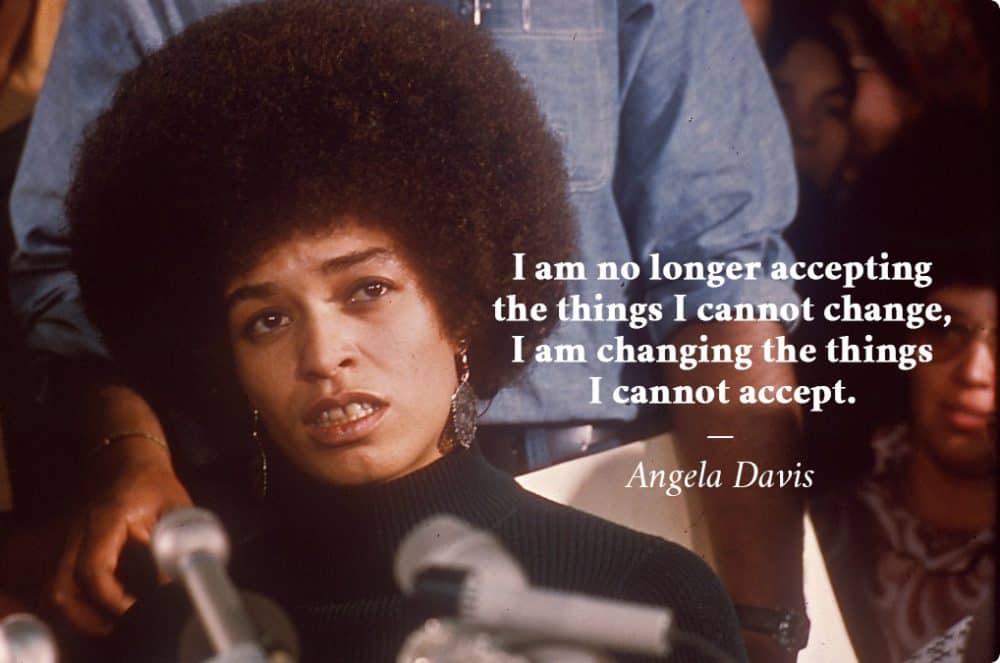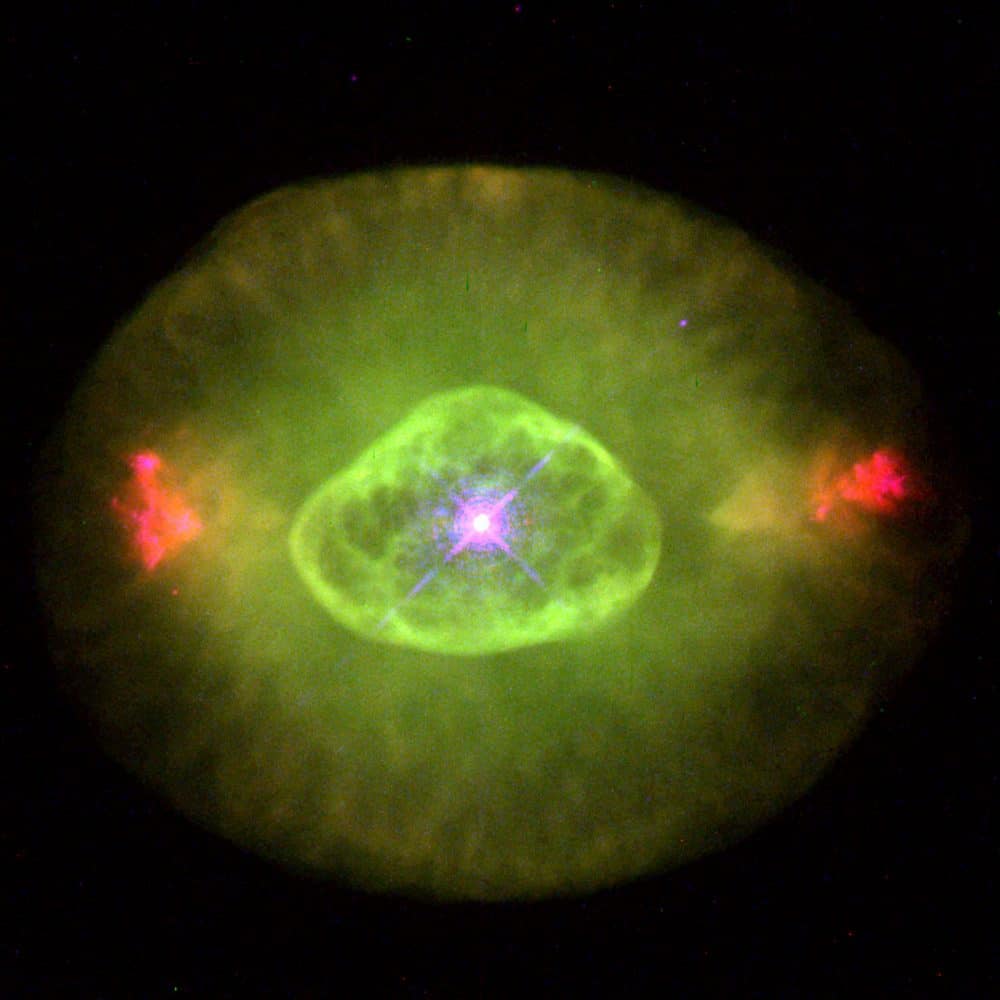Blog
“You can’t separate peace from freedom because no one can be at peace unless he has his freedom.”
more...
The streak is made mostly of glowing hydrogen that has been systematically stripped away as the galaxy moved through the ambient hot gas in a cluster of galaxies. Specifically, the galaxy is spiral galaxy D100, and cluster is the Coma Cluster of galaxies. The red path connects to the center of D100 because the outer gas, gravitationally held less strongly, has already been stripped away by ram pressure. The extended gas tail is about 200,000 light-years long, contains about 400,000 times the mass of our Sun, and stars are forming within it. Galaxy D99, visible to D100’s lower left, appears red because it glows primarily from the light of old red stars — young blue stars can no longer form because D99 has been stripped of its star-forming gas. The featured false-color picture is a digitally enhanced composite of images from Earth-orbiting Hubble and the ground-based Subaru telescope. Studying remarkable systems like this bolsters our understanding of how galaxies evolve in clusters.
more...Sarah Ann McLachlan, OC, OBC (born January 28, 1968) is a Canadian singer and songwriter known for her emotional ballads and mezzo-soprano vocal range. As of 2009 she had sold over 30 million albums worldwide. McLachlan’s best-selling album to date is Surfacing, for which she won two Grammy Awards (out of four nominations) and four Juno Awards. In addition to her personal artistic efforts, she founded the Lilith Fair tour, which showcased female musicians on an unprecedented scale. The Lilith Fair concert tours took place from 1997 to 1999, and resumed in the summer of 2010. On May 6, 2014, she released her first album of original music in four years, titled Shine On.
Was born on January 28, 1968, in Halifax, Nova Scotia, Canada, and placed with the McLachlan family who later legally adopted her. She played music from a very young age, beginning with the ukulele at age four. She would go on to study classical guitar, classical piano, and voice at the Maritime Conservatory of Music through the curriculum of The Royal Conse.
more...Bill Ware III born William Anthony Ware III (b. January 28, 1959, East Orange, New Jersey) is an American jazz vibraphonist.
Ware played bass and piano early in his career, playing at the Harlem Jazzmobile. After spending several years playing Latin jazz, he formed his own Latin Jazz group, AM Sleep. He joined the Jazz Passengers in 1987, and in 1990 put together a group of sidemen as the Club Bird All-Stars, who accompanied him on a tour of Japan. Alongside this, he played with Groove Collective and Steely Dan in the first half of the 1990s. Later in the decade he teamed up with fellow former Jazz Passengers, Brad Jones and E. J. Rodriguez, in the ensemble Vibes. His 2001 tribute to Duke Ellington was recorded with Marc Ribot on guitar. Deborah Harry guested on his 2002 effort Four. In the mid-2000s, Ware did several projects blending jazz with Western classical musicas well as 5 film scores (with fellow Jazz Passengers bandmate Roy Nathanson).
more...Charles Henry Tate, known as Baby Tate (January 28, 1920 – August 17, 1972) was an American Piedmont blues guitarist, who in a sporadic career spanning five decades worked with the guitarists Blind Boy Fuller and Pink Anderson and the harmonica player Peg Leg Sam. His playing style was influenced by Blind Blake, Buddy Moss, Blind Boy Fuller, Josh White, Willie Walker, and to some extent Lightnin’ Hopkins.
Tate was born in Elberton, Georgia, and was raised in Greenville, South Carolina. As an adolescent, he started performing locally, after seeing Blind Blake in Elberton.
more...“Freedom and justice cannot be parceled out in pieces to suit political convenience. I don’t believe you can stand for freedom for one group of people and deny it to others.” Coretta Scott King
more...
Dusty NGC 1333 is seen as a reflection nebula in visible light images, sporting bluish hues characteristic of starlight reflected by dust. But at longer infrared wavelengths, the interstellar dust itself glows – shown in red in this false-color Spitzer Space Telescope image. The penetrating infrared view also shows youthful stars that would otherwise still be obscured by the dusty clouds which formed them. Notably, greenish streaks and splotches that seem to litter the region trace the glow of cosmic jets blasting away from emerging young stellar objects as the jets plow into the cold cloud material. In all, the chaotic scene likely resembles one in which our own Sun formed over 4.5 billion years ago. NGC 1333 is a mere 1,000 light-years distant in the constellation Perseus.
more...Robert Hutcherson (January 27, 1941 – August 15, 2016) was an American jazz vibraphone and marimba player. “Little B’s Poem”, from the 1966 Blue Note album Components, is one of his best-known compositions. Hutcherson influenced younger vibraphonists including Steve Nelson, Joe Locke, and Stefon Harris.
Robert Calvin Bland (né Robert Calvin Brooks; January 27, 1930 – June 23, 2013), known professionally as Bobby “Blue” Bland, was an American blues singer.
Bland developed a sound that mixed gospel with the blues and R&B. He was described as “among the great storytellers of blues and soul music… [who] created tempestuous arias of love, betrayal and resignation, set against roiling, dramatic orchestrations, and left the listener drained but awed.”He was sometimes referred to as the “Lion of the Blues” and as the “Sinatra of the Blues”.His music was also influenced by Nat King Cole.
Bland was inducted into the Blues Hall of Fame in 1981, the Rock and Roll Hall of Fame in 1992, and the Memphis Music Hall of Fame in 2012. He received the Grammy Lifetime Achievement Award in 1997. The Rock and Roll Hall of Fame described him as “second in stature only to B.B. King as a product of Memphis‘s Beale Street blues scene”.
Bland was born Robert Calvin Brooks in the small town of Barretville, Tennessee
more...Elmore James (January 27, 1918 – May 24, 1963) was an American blues guitarist, singer, songwriter and bandleader. He was known as “King of the Slide Guitar” and was noted for his use of loud amplification and his stirring voice.
James was born Elmore Brooks in Richland, Holmes County, Mississippi, the illegitimate son of 15-year-old Leola Brooks, a field hand. His father was probably Joe Willie “Frost” James, who moved in with Leola, and Elmore took his surname. He began making music at the age of 12, using a simple one-string instrument (diddley bow, or jitterbug) strung on a shack wall. As a teen he performed at dances under the names Cleanhead and Joe Willie James. He married Minnie Mae about 1942. He subsequently married at least twice more.
James was strongly influenced by Robert Johnson, Kokomo Arnold and Tampa Red. He recorded several of Tampa Red’s songs. He also inherited from Tampa Red’s band two musicians who joined his own backing band, the Broomdusters, “Little” Johnny Jones (piano) and Odie Payne (drums). There is a dispute about whether Johnson or James wrote James’s signature song, “Dust My Broom”
https://www.youtube.com/watch?v=LqfcY11UGW4
more...NGC 6826 (also known as Caldwell 15) is a planetary nebula located in the constellation Cygnus. It is commonly referred to as the “blinking planetary”, although many other nebulae exhibit such “blinking”. When viewed through a small telescope, the brightness of the central star overwhelms the eye when viewed directly, obscuring the surrounding nebula. However, it can be viewed well using averted vision, which causes it to “blink” in and out of view as the observer’s eye wanders.
A distinctive feature of this nebula are the two bright patches on either side, which are known as Fast Low-Ionization Emission Regions, or FLIERS. They appear to be relatively young, moving outwards at supersonic speeds.
2000 ly
more...Anita Denise Baker (born January 26, 1958) is an American singer-songwriter. Starting her career in the late 1970s with the funk band Chapter 8, Baker released her first solo album, The Songstress, in 1983. In 1986, she rose to stardom following the release of her platinum-selling second album, Rapture, which included the Grammy-winning single “Sweet Love“. She is regarded as one of the most popular singers of soulful romantic ballads during the height of the quiet storm period of contemporary R&B in the 1980s. As of 2017, Baker has won eight Grammy Awards and has five platinum albums and one gold album. Her vocal range is contralto.
Anita Baker was born on January 26, 1958 in Toledo, Ohio. When she was two, her mother abandoned her and Baker was raised by a foster family in Detroit, Michigan. When Baker was 12, her foster parents died and her foster sister raised her afterwards. By the time Baker was 16, she began singing R&B at Detroit nightclubs. After one performance, she was discovered by bandleader David Washington, who gave her a card to audition for the funk band, Chapter 8.
https://www.youtube.com/watch?v=TEtAx1n2jbQ
more...Huey Pierce Smith, known as Huey “Piano” Smith (born January 26, 1934, New Orleans, Louisiana), is an American rhythm-and-blues pianist whose sound was influential in the development of rock and roll.
His piano playing incorporated the boogie styles of Pete Johnson, Meade Lux Lewis, and Albert Ammons, the jazz style of Jelly Roll Morton and the rhythm-and-blues style of Fats Domino.AllMusic journalist Steve Huey noted that “At the peak of his game, Smith epitomized New Orleans R&B at its most infectious and rollicking, as showcased on his classic signature tune, ‘Don’t You Just Know It.'”
Smith was born in the Central City neighborhood of New Orleans. He was influenced by the innovative work of Professor Longhair. He became known for his shuffling right-handed break on the piano that influenced other Southern players.
Smith wrote his first song on the piano, “Robertson Street Boogie” (named after the street where he lived), when he was eight years old. He performed the tune with a friend; they billed themselves as Slick and Dark. Smith attended McDowell High School and Xavier University of Louisiana in New Orleans.
When Smith was fifteen, he began working in clubs and recording with his flamboyant partner, Eddie Jones, who rose to fame as Guitar Slim. When Smith was eighteen, in 1952, he signed a recording contract with Savoy Records, which released his first known single, “You Made Me Cry”. In 1953 Smith recorded with Earl King.
In 1955, Smith became the piano player with Little Richard‘s first band in sessions for Specialty Records. The same year he also played piano on several studio sessions for other artists, such as Lloyd Price. Two of the sessions resulted in hits for Earl King (“Those Lonely Lonely Nights”) and Smiley Lewis (“I Hear You Knocking“).
more...Clement Seymour “Sir Coxsone” Dodd CD (26 January 1932 – 5 May 2004) was a Jamaican record producer who was influential in the development of ska and reggae in the 1950s, 1960s and beyond.
He was nicknamed “Coxsone” at school due to his talent as a cricketer (his friends compared him to Alec Coxon, a member of the 1940s Yorkshire County Cricket Club team). The Kingston-born Dodd used to play records to the customers in his parents’ shop. During a spell in the American South he became familiar with the rhythm and blues music popular there at the time. In 1954, back in Jamaica, he set up the Downbeat Sound System, being the owner of an amplifier, a turntable, and some US records, which he would import from New Orleansand Miami.
More Posts
- Daily Roots the Gladiators
- What happened to the brilliant minds and heartfelt leaders?
- Cosmos Sh2-155
- Jim Croce
- Mike Stern
- Max Roach
- World Music KITKA
- Daily Roots Jackie Brown
- Cosmos NGC 2359
- Jimi Page
- Joan Báez
- Kenny Clarke
- Bucky Pizzarelli
- World Fusion Ablaye Cissoko & Cyrille Brotto
- Daily Roots Junior Marvin
- Cosmos Arp 122
- Shirley Bassey
- David Bowie
- Elvis Presley
- Dave Weckl
